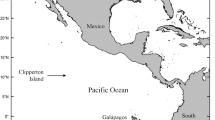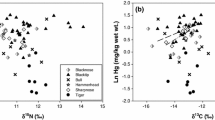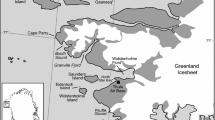Abstract
We measured total mercury (THg) concentrations in California sea lions (Zalophus californianus) and examined how concentrations varied with age class, colony, and sex. Because Hg exposure is primarily via diet, we used nitrogen (δ 15N) and carbon (δ 13C) stable isotopes to determine if intraspecific differences in THg concentrations could be explained by feeding ecology. Blood and hair were collected from 21 adult females and 57 juveniles from three colonies in central and southern California (San Nicolas, San Miguel, and Año Nuevo Islands). Total Hg concentrations ranged from 0.01 to 0.31 μg g−1 wet weight (ww) in blood and 0.74 to 21.00 μg g−1 dry weight (dw) in hair. Adult females had greater mean THg concentrations than juveniles in blood (0.15 vs. 0.03 μg−1 ww) and hair (10.10 vs. 3.25 μg−1 dw). Age class differences in THg concentrations did not appear to be driven by trophic level or habitat type because there were no differences in δ 15N or δ 13C values between adults and juveniles. Total Hg concentrations in adult females were 54 % (blood) and 24 % (hair) greater in females from San Miguel than females from San Nicolas Island, which may have been because sea lions from the two islands foraged in different areas. For juveniles, we detected some differences in THg concentrations with colony and sex, although these were likely due to sampling effects and not ecological differences. Overall, THg concentrations in California sea lions were within the range documented for other marine mammals and were generally below toxicity benchmarks for fish-eating wildlife.




Similar content being viewed by others
References
Ackerman JT, Eagles-Smith CA, Takekawa JY et al (2007) Mercury concentrations and space use of pre-breeding American avocets and black-necked stilts in San Francisco Bay. Sci Total Environ 384:452–466
Ackerman JT, Eagles-Smith CA, Herzog MP (2011) Bird mercury concentrations change rapidly as chicks age: toxicological risk is highest at hatching and fledging. Environ Sci Technol 45:5418–5425
Agusa T, Nomura K, Kunito T et al (2011) Accumulation of trace elements in harp seals (Phoca groenlandica) from Pangnirtung in the Baffin Island, Canada. Mar Pollut Bull 63:489–499
Aubail A, Teilmann J, Dietz R et al (2011) Investigation of mercury concentrations in fur of phocid seals using stable isotopes as tracers of trophic levels and geographical regions. Polar Biol 34:1411–1420
Basu N, Klenavic K, Gamberg M et al (2005) Effects of mercury on neurochemical receptor-binding characteristics in wild mink. Environ Toxicol Chem 24:1444–1450
Basu N, Scheuhammer AM, Sonne C et al (2009) Is dietary mercury of neurotoxicological concern to wild polar bears (Ursus maritimus)? Environ Toxicol Chem 28:133–140
Basu N, Scheuhammer AM, Rouvinen-Watt K et al (2010) In vitro and whole animal evidence that methylmercury disrupts GABAergic systems in discrete brain regions in captive mink. Comp Biochem Physiol C 151:379–385
Beckmen KB, Duffy LK, Zhang X, Pitcher KW (2002) Mercury concentrations in the fur of Steller sea lions and northern fur seals from Alaska. Mar Pollut Bull 44:1130–1135
Ben-David M, Duffy LK, Blundell GM, Bowyer RT (2001) Natural exposure of coastal river otters to mercury: relation to age, diet, and survival. Environ Toxicol Chem 20:1986–1992
Burns JM, Clark CA, Richmond JP (2004) The impact of lactation strategy on physiological development of juvenile marine mammals: implications for the transition to independent foraging. Int Congr Ser 1275:341–350
Cardona-Marek T, Knott KK, Meyer BE, O’Hara TM (2009) Mercury concentrations in southern Beaufort sea polar bears: variation based on stable isotopes of carbon and nitrogen. Environ Toxicol Chem 28:1416–1424
Carlson JR, Cristol D, Swaddle JP (2014) Dietary mercury exposure causes decreased escape takeoff flight performance and increased molt rate in European starlings (Sturnus vulgaris). Ecotoxicology 23:1464–1473
Carretta JV, Oleson E, Weller D et al (2014) US pacific marine mammal stock assessments, 2013. NOAA-TM-NMFS-SWFSC-532
Castellini JM, Rea LD, Lieske CL et al (2012) Mercury concentrations in hair from neonatal and juvenile Steller sea lions (Eumetopias jubatus): implications based on age and region in this northern Pacific marine sentinel piscivore. EcoHealth 9:267–277
Childerhouse SJ, Dawson SJ, Fletcher DJ et al (2010) Growth and reproduction of female New Zealand sea lions. J Mammal 91:165–176
Correa L, Castellini JM, Wells RS, O’Hara T (2013) Distribution of mercury and selenium in blood compartments of bottlenose dolphins (Tursiops truncatus) from Sarasota Bay, Florida. Environ Toxicol Chem 32:2441–2448
Costa DP, Gales NJ (2003) Energetics of a benthic diver: seasonal foraging ecology of the Australian sea lion, Neophoca cinerea. Ecol Monogr 73:27–43
Das K, Siebert U, Gillet A et al (2008) Mercury immune toxicity in harbour seals: links to in vitro toxicity. Environ Health 7:52
Dietz R, Born EW, Rigét F et al (2011) Temporal trends and future predictions of mercury concentrations in Northwest Greenland polar bear (Ursus maritimus) hair. Environ Sci Technol 45:1458–1465
Dietz R, Sonne C, Basu N et al (2013) What are the toxicological effects of mercury in Arctic biota? Sci Total Environ 443:775–790
Evers DC, Kaplan JD, Meyer MW et al (1998) Geographic trend in mercury measured in common loon feathers and blood. Environ Toxicol Chem 17:173–183
Evers DC, Burgess NM, Champoux L et al (2005) Patterns and interpretation of mercury exposure in freshwater avian communities in northeastern north America. Ecotoxicology 14:193–221
Evers DC, Savoy LJ, DeSorbo CR et al (2008) Adverse effects from environmental mercury loads on breeding common loons. Ecotoxicology 17:69–81
Fevold BM, Meyer MW, Rasmussen PW, Temple SA (2003) Bioaccumulation patterns and temporal trends of mercury exposure in Wisconsin common loons. Ecotoxicology 12:83–93
Fitzgerald WF, Lamborg CH, Hammerschmidt CR (2007) Marine biogeochemical cycling of mercury. Chem Rev 107:641–662
Frederick P, Jayasena N (2011) Altered pairing behaviour and reproductive success in white ibises exposed to environmentally relevant concentrations of methylmercury. Proc Biol Sci 278:1851–1857
Goutte A, Bustamante P, Barbraud C et al (2014) Demographic responses to mercury exposure in two closely related Antarctic top predators. Ecology 95:1075–1086
Habran S, Debier C, Crocker DE et al (2011) Blood dynamics of mercury and selenium in northern elephant seals during the lactation period. Environ Pollut 159:2523–2529
Harper ER, St Leger JA, Westberg JA et al (2007) Tissue heavy metal concentrations of stranded California sea lions (Zalophus californianus) in Southern California. Environ Pollut 147:677–682
Harris HH, Pickering IJ, George GN (2003) The chemical form of mercury in fish. Science 301:1203
Hilderbrand GV, Farley SD, Robbins CT et al (1992) Use of stable isotopes to determine diets of living and extinct bears. Can J Zool 74:2080–2088
Hoskins AJ, Arnould JPY (2013) Temporal allocation of foraging effort in female Australian fur seals (Arctocephalus pusillus doriferus). PLoS One 8:e79484
Ikemoto T, Kunito T, Watanabe I et al (2004) Comparison of trace element accumulation in Baikal seals (Pusa sibirica), Caspian seals (Pusa caspica) and northern fur seals (Callorhinus ursinus). Environ Pollut 127:83–97
Kuhn CE, Costa DP (2014) Interannual variation in the at-sea behavior of California sea lions (Zalophus californianus). Mar Mammal Sci 30:1297–1319
Lavoie RA, Jardine TD, Chumchal MM et al (2013) Biomagnification of mercury in aquatic food webs: a worldwide meta-analysis. Environ Sci Technol 47:13385–13394
Lieske CL, Moses SK, Castellini JM et al (2011) Toxicokinetics of mercury in blood compartments and hair of fish-fed sled dogs. Acta Vet Scand 53:66
Martin JH, Elliott PD, Anderlini VC et al (1976) Mercury-selenium-bromine imbalance in premature parturient California sea lions. Mar Biol 35:91–104
McHuron EA, Harvey JT, Castellini JM, O’Hara TM (2012) Hair sampling location in harbor seals (Phoca vitulina) affects selenium and mercury concentrations: implications for study design of trace element determination in pinnipeds. Mar Pollut Bull 64:2519–2522
McHuron EA, Harvey JT, Castellini JM et al (2014) Selenium and mercury concentrations in harbor seals (Phoca vitulina) from central California: health implications in an urbanized estuary. Mar Pollut Bull 83:48–57
Melin SR, Delong RL, Thomason JR, VanBlaricom GR (2000) Attendance patterns of California sea lion (Zalophus californianus) females and pups during the non-breeding season at San Miguel Island. Mar Mammal Sci 16:169–185
Melin S, DeLong R, Siniff D (2008) The effects of El Niño on the foraging behavior of lactating California sea lions (Zalophus californianus californianus) during the nonbreeding season. Can J Zool 86:192–206
Mergler D, Anderson HA, Chan LHM et al (2007) Methylmercury exposure and health effects in humans: a worldwide concern. Ambio 36:3–11
Orr A, VanBlaricom G, DeLong R et al (2011) Intraspecific comparison of diet of California sea lions (Zalophus californianus) assessed using fecal and stable isotope analyses. Can J Zool 89:109–122
Orr AJ, Newsome SD, Laake JL et al (2012) Ontogenetic dietary information of the California sea lion (Zalophus californianus) assessed using stable isotope analysis. Mar Mammal Sci 28:714–732
Peterson RS, Bartholomew GA (1967) The natural history and behavior of the California sea lion. American Society of Mammalogists, Stillwater
Peterson SH, Ackerman JT, Costa DP (2015a) Marine foraging ecology influences mercury bioaccumulation in deep-diving northern elephant seals. Proc R Soc B 282:20150710
Peterson SH, McHuron EA, Kennedy SN et al (2015b) Evaluating hair as a predictor of blood mercury: the influence of ontogenetic phase and life history in pinnipeds. Arch Environ Contam Toxicol. doi:10.1007/s00244-015-0174-3
Porras-Peters H, Aurioles-Gamboa D, Cruz-Escalona VH, Koch PL (2008) Trophic level and overlap of sea lions (Zalophus californianus) in the Gulf of California, Mexico. Mar Mammal Sci 24:554–576
Rea LD, Castellini JM, Correa L et al (2013) Maternal Steller sea lion diets elevate fetal mercury concentrations in an area of population decline. Sci Total Environ 454–455:277–282
Scheuhammer AM, Meyer MW, Sandheinrich MB, Murray MW (2007) Effects of environmental methylmercury on the health of wild birds, mammals, and fish. Ambio 36:12–18
Schulz TM, Bowen WD (2004) Pinniped lactation strategies: evaluation of data on maternal and offspring life history traits. Mar Mammal Sci 20:86–114
St Louis VL, Derocher AE, Stirling I et al (2011) Differences in mercury bioaccumulation between polar bears (Ursus maritimus) from the Canadian high- and sub-Arctic. Environ Sci Technol 45:5922–5928
Stavros H-CW, Bossart GD, Hulsey TC, Fair PA (2008) Trace element concentrations in blood of free-ranging bottlenose dolphins (Tursiops truncatus): influence of age, sex and location. Mar Pollut Bull 56:371–379
United States Environmental Protection Agency (2000) Method 7473, test methods for evaluating solid waste, physical/chemical methods. SW 846, Update IVA
Wagemann R, Stewart REA, Lockhart WL et al (1988) Trace metals and methyl mercury: associations and transfer in harp seal (Phoca groenlandica) mothers and their pups. Mar Mammal Sci 4:339–355
Wang W, Evans RD, Hickie BE et al (2014) Methylmercury accumulation and elimination in mink (Neovison vison) hair and blood: results of a controlled feeding experiment using stable isotope tracers. Environ Toxicol Chem 33:2873–2880
Weise M, Harvey J (2008) Temporal variability in ocean climate and California sea lion diet and biomass consumption: implications for fisheries management. Mar Ecol Prog Ser 373:157–172
Williams TM, Rutishauser M, Long B et al (2007) Seasonal variability in otariid energetics: implications for the effects of predators on localized prey resources. Physiol Biochem Zool 80:433–443
Winship AJ, Trites AW, Calkins DG (2001) Growth in body size of Steller sea lion (Eumetopias jubatus). J Mammal 82:500–519
Wintle NJP, Duffield DA, Barros NB et al (2011) Total mercury in stranded marine mammals from the Oregon and southern Washington coasts. Mar Mammal Sci 27:E268–E278
Woshner V, Knott K, Wells R et al (2008) Mercury and selenium in blood and epidermis of bottlenose dolphins (Tursiops truncatus) from Sarasota Bay, FL: interaction and relevance to life history and hematologic parameters. EcoHealth 5:360–370
Zhao L, Schell DM, Castellini MA (2006) Dietary macronutrients influence 13C and 15N signatures of pinnipeds: captive feeding studies with harbor seals (Phoca vitulina). Comp Biochem Physiol A 143:469–478
Acknowledgments
All animals were sampled in conjunction with other studies under National Marine Fisheries Permit Nos. 14676, 16087, 17115, and 17952 and approved Institutional Animal Care and Use Committee protocols from the University of California Los Angeles, University of California San Diego, and the National Marine Mammal Laboratory. We thank the United States Navy (especially J. Ugoretz), the staff at Channel Islands National Park and Channel Islands Aviation for logistical support, rangers at Año Nuevo State Reserve, and all of the volunteers who assisted in animal capture and sample collection. We especially thank P. Ponganis, M. Tift, K. Prager, and J. Lloyd-Smith. Funding support for E.A. McHuron was provided by the Office of Naval Research (ONR N00014-13-1-0134), the Joint Industry Programme (JIP22 07-23), and a Friends of Long Marine Laboratory Student Research and Education Award. Funding support for J.T. Ackerman was provided by the U.S. Geological Survey Western Ecological Research Center. The use of trade, product, or firm names in this publication is for descriptive purposes only and does not imply endorsement by the United States Government.
Author information
Authors and Affiliations
Corresponding author
Rights and permissions
About this article
Cite this article
McHuron, E.A., Peterson, S.H., Ackerman, J.T. et al. Effects of Age, Colony, and Sex on Mercury Concentrations in California Sea Lions. Arch Environ Contam Toxicol 70, 46–55 (2016). https://doi.org/10.1007/s00244-015-0201-4
Received:
Accepted:
Published:
Issue Date:
DOI: https://doi.org/10.1007/s00244-015-0201-4




